
Above: Left: Rachel Claire / Right: Tomates Farcie by Jérôme Decq
One of the first complete sentences I learned to say in French was “Qu’est-ce qu’on va manger aujourd’hui?” or, “What are we going to eat today?” Studying a new language exposes your priorities. You realize with urgency the words that you use the most, and must therefore master the fastest. In my case, they all happened to revolve around food! You can bet I got my “Un croissant, s’il vous plait!” practiced and mastered first thing after arriving in Paris.
I moved to Paris last September. Along with the million and one things to worry about while moving countries, I also faced the intimidating prospect of meeting my (then future) French mother-in-law, Maria. For a lot of people, this moment usually happens during the dating phase. In my case, due to the constraints of a long-distance relationship and a raging pandemic, my partner and I were already engaged to be married by the time I met Maria.
The stakes were high! What if we didn’t get along? Quelle horreur! Luckily, all my consternations were for naught. Turns out, we were a match made in heaven: I love to eat and she loves to feed.

In between my (at that point in time) terrible French and her limited English, we managed to forge a bond. As in most households, the dining table was the hub of our conversations and food became the catalyst for forming a connection. Like someone once said, “The best memories are made around the table.” There was always something new to drink or to taste, or some novel dish for us to prepare together!
Over the last year, as our relationship has changed and progressed, food still remains an enduring association that binds me to Maria’s home and keeps me wanting to return and break bread at her table, time and again. Hence, here I am sharing some of my favorite dishes of hers, and some of the memories that make them so special. All these dishes are autumnal and comforting, and they capture the essence of French cuisine from the South of France, where my husband’s family is from.

Cassoulet
It’s a slow cooked stew made with white beans, sausages, and pork. The name of the dish arises from the vessel in which it is traditionally cooked: a casserole, which is a type of earthen pot. Maria usually cooks this dish with duck fat, another ingredient traditionally used in the South of France. The resulting deliciousness can only be described as a warm hug, or a cozy blanket, if you will. Cassoulet is serious matter in the south, with the cities of Toulouse, Carcassonne, and Castelnaudary forming the so-called “holy trinity” of cassoulet, each with their own recipes.
Find the recipe for Toulousian Cassoulet here

Tomates Farcies
This stuffed tomato dish is a staple in any French home. It’s easy to make with a few simple ingredients such as ground meat, spices, eggs, milk, and bread. What makes Maria’s tomates farcies absolutely memorable are her delicious home-grown tomatoes. In fact, she grows almost all her fresh vegetables in a garden she single-handed transformed from an arid, empty plot of land to a thriving green oasis. Eating foods from her garden, whether in a salad or with delicious stuffed meat, is always a reminder of her incredible work ethic and passion for meaningful actions.


Saucisses aux Lentilles
As an Indian, lentils are an integral part of my diet. I was ready to teach my mom-in-law a thing or two about dal, an Indian lentil dish. I arrived at her home, armed with my stash of lentils and spices from the Indian supermarket in Paris. Little did I know, she had a classic French lentil dish in her arsenal too, and it left me surprised but wanting more. So simple, so yummy, so French: green lentils with sausage! I now list this dish as essential to surviving French winters!

Pot-au-Feu
My husband and I had planned our wedding as an intimate affair with limited guests in a tiny castle tucked away in the South of France. While the festivities on that day were memorable, the next morning was rough. As all the hungover guests left the venue, we were invited for lunch at Maria’s. She managed to not only dance to “Born to Be Wild” on the night of the party, get up before any of us, and host lunch the next day…but she also cooked what I henceforth call the “elixir of life”: pot-au-feu!
This humble slow-cooked stock of meat and vegetable is called a French national dish by some. It’s usually served at Christmas, or after any event with over-indulgent eating and drinking. This is definitely the mother of all French bouillons and a must-try!

Related Links
- For some more French food adventures, Top 5 Freaky French Foods We’re Still Scared To Eat
- The Best French Salads to Make at Home
- Or try making some French desserts at home!
Written by Pronoti Baglary for HiP Paris. Looking to travel? Check out Haven In for a fabulous vacation rental in Paris, France or Italy. Looking to rent long-term or buy in France or Italy? Ask us! We can connect you to our trusted providers for amazing service and rates.























I really thought those pictures (with food) were taken from the your MIL’s kitchen until I realized the credit.
I was disappointed that the recipes were not from your mother-in-law but just links to various sites with recipes for the dishes you mentioned. We all know that all recipes are not alike.